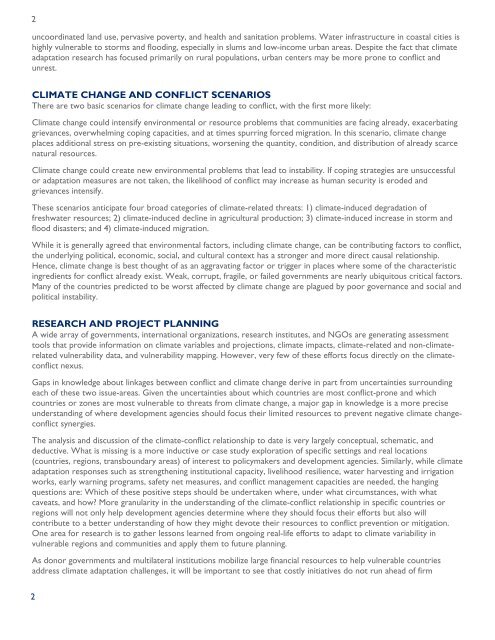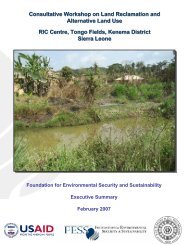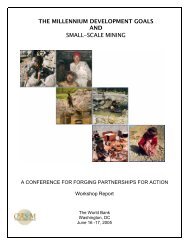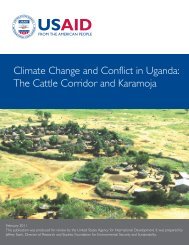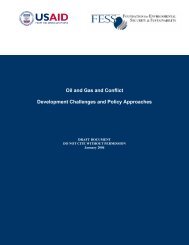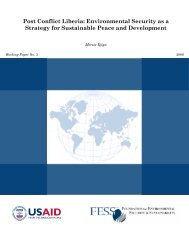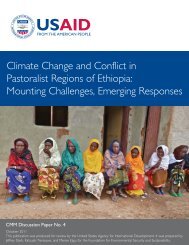Climate Change, Adaptation, and Conflict - FESS :: Foundation for ...
Climate Change, Adaptation, and Conflict - FESS :: Foundation for ...
Climate Change, Adaptation, and Conflict - FESS :: Foundation for ...
You also want an ePaper? Increase the reach of your titles
YUMPU automatically turns print PDFs into web optimized ePapers that Google loves.
2uncoordinated l<strong>and</strong> use, pervasive poverty, <strong>and</strong> health <strong>and</strong> sanitation problems. Water infrastructure in coastal cities ishighly vulnerable to storms <strong>and</strong> flooding, especially in slums <strong>and</strong> low-income urban areas. Despite the fact that climateadaptation research has focused primarily on rural populations, urban centers may be more prone to conflict <strong>and</strong>unrest.CLIMATE CHANGE AND CONFLICT SCENARIOSThere are two basic scenarios <strong>for</strong> climate change leading to conflict, with the first more likely:<strong>Climate</strong> change could intensify environmental or resource problems that communities are facing already, exacerbatinggrievances, overwhelming coping capacities, <strong>and</strong> at times spurring <strong>for</strong>ced migration. In this scenario, climate changeplaces additional stress on pre-existing situations, worsening the quantity, condition, <strong>and</strong> distribution of already scarcenatural resources.<strong>Climate</strong> change could create new environmental problems that lead to instability. If coping strategies are unsuccessfulor adaptation measures are not taken, the likelihood of conflict may increase as human security is eroded <strong>and</strong>grievances intensify.These scenarios anticipate four broad categories of climate-related threats: 1) climate-induced degradation offreshwater resources; 2) climate-induced decline in agricultural production; 3) climate-induced increase in storm <strong>and</strong>flood disasters; <strong>and</strong> 4) climate-induced migration.While it is generally agreed that environmental factors, including climate change, can be contributing factors to conflict,the underlying political, economic, social, <strong>and</strong> cultural context has a stronger <strong>and</strong> more direct causal relationship.Hence, climate change is best thought of as an aggravating factor or trigger in places where some of the characteristicingredients <strong>for</strong> conflict already exist. Weak, corrupt, fragile, or failed governments are nearly ubiquitous critical factors.Many of the countries predicted to be worst affected by climate change are plagued by poor governance <strong>and</strong> social <strong>and</strong>political instability.RESEARCH AND PROJECT PLANNINGA wide array of governments, international organizations, research institutes, <strong>and</strong> NGOs are generating assessmenttools that provide in<strong>for</strong>mation on climate variables <strong>and</strong> projections, climate impacts, climate-related <strong>and</strong> non-climaterelatedvulnerability data, <strong>and</strong> vulnerability mapping. However, very few of these ef<strong>for</strong>ts focus directly on the climateconflictnexus.Gaps in knowledge about linkages between conflict <strong>and</strong> climate change derive in part from uncertainties surroundingeach of these two issue-areas. Given the uncertainties about which countries are most conflict-prone <strong>and</strong> whichcountries or zones are most vulnerable to threats from climate change, a major gap in knowledge is a more preciseunderst<strong>and</strong>ing of where development agencies should focus their limited resources to prevent negative climate changeconflictsynergies.The analysis <strong>and</strong> discussion of the climate-conflict relationship to date is very largely conceptual, schematic, <strong>and</strong>deductive. What is missing is a more inductive or case study exploration of specific settings <strong>and</strong> real locations(countries, regions, transboundary areas) of interest to policymakers <strong>and</strong> development agencies. Similarly, while climateadaptation responses such as strengthening institutional capacity, livelihood resilience, water harvesting <strong>and</strong> irrigationworks, early warning programs, safety net measures, <strong>and</strong> conflict management capacities are needed, the hangingquestions are: Which of these positive steps should be undertaken where, under what circumstances, with whatcaveats, <strong>and</strong> how? More granularity in the underst<strong>and</strong>ing of the climate-conflict relationship in specific countries orregions will not only help development agencies determine where they should focus their ef<strong>for</strong>ts but also willcontribute to a better underst<strong>and</strong>ing of how they might devote their resources to conflict prevention or mitigation.One area <strong>for</strong> research is to gather lessons learned from ongoing real-life ef<strong>for</strong>ts to adapt to climate variability invulnerable regions <strong>and</strong> communities <strong>and</strong> apply them to future planning.As donor governments <strong>and</strong> multilateral institutions mobilize large financial resources to help vulnerable countriesaddress climate adaptation challenges, it will be important to see that costly initiatives do not run ahead of firm2


